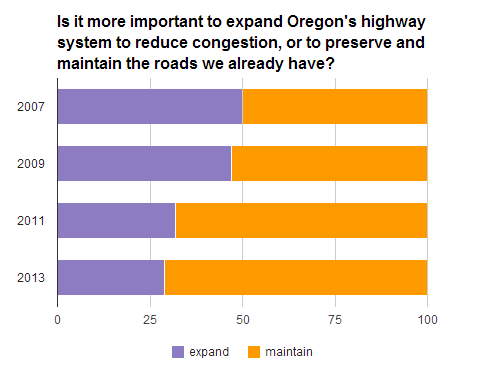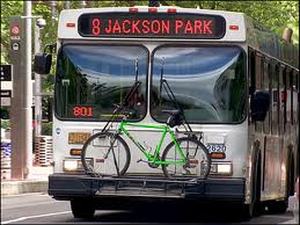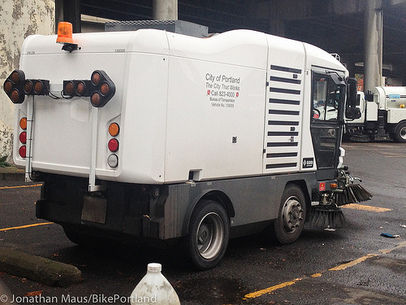|
The Portland Bureau of Transportation is working on a project to plan, design and construct safety improvements to a 9.1 mile north-south bicycle route. The route uses a variety of local residential streets and neighborhood collector streets between NE/SE 26th and 29th Aves. It runs from NE Lombard St at the north end of the City to connect to the Springwater Corridor at SE 45th Ave at the south end of the City. The project is funded through a $2.4 million federal grant.
PBOT will hold three open houses where you can learn more and provide input. The first open house will be held Thursday, March 13th from 6:00 – 8:30 p.m. at the Fremont United Methodist Church at 2620 NE Fremont. The same material will be presented at open houses in SE Portland on March 17 and March 18 at Cleveland High School and Central Catholic High School, respectively. For more information on the project, including draft maps, documents and Stakeholder Advisory Committee notes, see the project webpage.
0 Comments
From bikeportland.org:
As recently as 2007, almost 50 percent of Oregonians said it was more important "to expand the highway system to reduce traffic congestion" than "to preserve and maintain the highways Oregon already has." As of this year, that's fallen to 29 percent. Read more here. Starting Sunday, March 2, 2014, TriMet will bring back 15-minute service throughout the day on weekdays for it's Frequent Service lines, including line 8, which runs through Sabin. From Neil McFarlane, General Manager at TriMet:
"Thanks to an improving budget outlook, we are happy to begin restoring 15-minute service—which had been cut over the last few years due to the recession—starting with mid-day hours on weekdays... For riders, this means less waiting, shorter travel times and better connections. Before the recession, “Frequent Service” meant that buses and MAX came every 15 minutes or better throughout the day, every day. We had to temporarily reduce frequency on these and other lines due to budget shortfalls. Today, we are in a position to begin restoring service, due to increased revenue from advertising, and lower health insurance costs for non-union employees. Restoring Frequent Service has been a top priority for me, and improving mid-day service is just the first step. It will probably take a few years to get back to 15-minute frequency all day, every day—meaning evenings and weekends, too—but that’s our goal." Sign up for service alerts by email here. from BikePortland.org...
"We're happy to report that PBOT has taken delivery of a new sweeper that is specifically designed to fit inside narrow bike paths. Their new RAVO 5-Series sweeper has only been in service since last month, but it's already gotten a lot of action. PBOT spokeswoman Diane Dulken said it can sweep the new bikeways on NE Cully Blvd, SW Broadway, and NE Multnomah thanks to its narrow profile and agile handling." On Wednesday, October 9th Sabin School will participate in International Walk + Bike to School Day!
We will join together with over 4 million kids in more than 40 countries to take strides to make ourselves healthier and our world a better place. Our steps are real action toward solving the health, economic and environmental problems that our communities face today. This one day event can be a catalyst for habitual, healthy activity--for ourselves and kids as well as our environment. Providing them with positive experiences walking and biking to school will pave the way for being physically active throughout their lives! Did I mention prizes and swag?! We will have a drawing for a Nutcase Helmet! We'll also have other fun freebies given to us by Oregon Safe Routes to School. Hot chocolate will be provided for the early arrivals! Please contact Liberty Wilson, [email protected], if you would like to help volunteer with this event or future events. - Liberty Wilson In the early days, most people in Portland lived within a mile or two of the city and walked everywhere. Then, in 1872, Ben Holladay built the city’s first horse-drawn streetcar line, which ran along First Street. According to historian Mark Moore, “the early horse-drawn streetcars were soon joined by and later replaced by steam trains and eventually electric trolleys. Portland’s first electric streetcar took to the rails in 1889 and carried passengers across the Steel Bridge to the town of Albina.”
Moore explains that the expanding streetcar lines allowed residents to live farther from the center of the town. “Real estate developers created the communities of Council Crest, Hawthorne, Irvington and Mount Tabor, as well as others, as the streetcar lines lured people away from the central city to live in the suburbs.” The Irvington streetcar line originally came across the Steel Bridge, went north on Grand, east on Multnomah, north on 15th, then ran east on Tillamook. In 1910, the east turn at Tillamook was abandoned and instead the car continued north to Siskiyou. In 1913, the line was extended further north to Prescott. Historian Richard Thompson notes that,“by the time ridership peaked in 1922, street railways had become more than a means of transportation. During hot summer evenings, families relaxed in open cars; and on Sundays, people rode to the end of the line for a day of picnicking, hiking, or fishing. Trolley parks such as Council Crest and Oaks Park offered attractions including amusement rides, dance bands, and roller skating. People also rode streetcars to racetracks, golf courses, and beaches.” Thompson explains: “Affordable automobiles, better roads, and the rising cost of labor eventually changed all of that. By the late 1920s, people were increasingly envious of the freedom and status that came with owning an automobile... The last three city streetcar lines were converted to bus operation in 1950 and the final interurban line ceased operating in 1958.” The Irvington line was converted to bus in 1940. Sources: Mark Moore – pdxhistory.com Richard Thompson –oregonencyclopedia.org Portland Vintage Trolleys – vintagetrolleys.com Carl Townsend – irvingtonpdx.com The City of Portland and Portland State University are teaming up for the 22nd year to offer the Portland Traffic and Transportation class. For ten weeks, this free class gives neighborhood activists the opportunity to meet with local policymakers, political leaders and planners to gain a better understanding of the metro area’s transportation system. Class participants also work directly with former Metro Executive Officer and current Shiels Obletz Johnsen principal Rick Gustafson on their own neighborhood transportation or livability projects. Gustafson developed the class in concert with Congressman Earl Blumenauer and is a knowledgeable leader on transportation and community development. The class fills quickly, so fill out the scholarship application today!
Neighborhood Greenways are residential streets where bicycles and pedestrians are given priority. As part of the Neighborhood Greenways program, the Portland Bureau of Transportation (PBOT) is installing artistic street sign toppers to help people identify the Greenway. PBOT also uses speed bumps, traffic diverters and pavement markings to slow auto traffic and reduce cut-throughs along these streets.
This spring and summer, PBOT will be hosting community events on the Going Street Greenway and offering promotional incentives to residents and businesses near the street. Funding for the Neighborhood Greenway outreach project comes from a grant awarded by the Oregon Department of Transportation. The grant project, called “Going to the River,” funds bicycle and pedestrian improvements in North and Northeast Portland, including Swan Island. For more information visit www.NeighborhoodGreenways.org click on the “Going to the River” link or contact Scott Cohen at (503) 823-5345 or [email protected]. |
Categories
All
Archives
September 2023
|










 RSS Feed
RSS Feed
